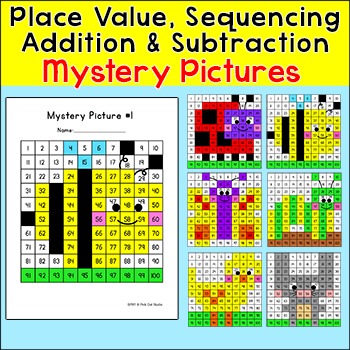Spring Color by Code 100s Chart Mystery Pictures - Hidden Picture Math Activity
- Zip
What educators are saying
Description
Practice place value, sequencing, addition and subtraction with these fun Spring / Summer theme Mystery Pictures. These activities are perfect for math centers, early finishers, substitutes or homework. With 11 different question types per mystery picture, you can choose the most appropriate question set for your students. This makes the activity perfect for differentiation and the worksheets will be appropriate for many grade levels.
Using the hundreds chart, students will have fun answering questions to reveal a Spring mystery picture.
There are 6 mystery pictures included in this bundle: Bee, Ladybug, Butterfly, Bird, Caterpillar, Bunny.
Each mystery picture has 11 question worksheets to choose from:
- place value: e.g. 5 tens 7 ones
- Sequencing : e.g. 56,__,58
- easy addition : number plus 1 to 5. e.g. 54+3=?
- medium addition: number plus 6 to 10. e.g. 48+9=?
- hard addition: double digit addition. e.g. 25+32=?
- easy subtraction : number minus 1 to 5. e.g. 59-2=?
- medium subtraction : number minus 6 to 10. e.g. 65-8=?
- hard subtraction : double digit subtraction. e.g. 89-32=?
- easy addition and subtraction mix
- medium addition and subtraction mix
- hard addition and subtraction mix
Answer keys are included for each mystery picture and each question type.
You may like my other Spring activities:
- Sight Words Sentence Scramble
- Spring Bees Interactive Attendance
- Spring Coordinate Graphing Mystery Pictures
Click a link below to see all activities in that category:
- Math Color-by-Code Worksheets
- Sight Words Mystery Pictures
- Sight Words Color-by-Code Worksheets
You may also like my Insects Activities:
- Coordinate Graphing Mystery Pictures Bundle
- Mystery Pictures Math Bundle
- Punch Cards for Rewards and Behavior Management
- Insects File Folder Games Bundle
You may like my other Mystery Pictures worksheets.
Place Value, Addition & Subtraction
- Spring
- Monsters
Coordinate Graphing:
- Spring Bee, Butterfly, Ladybug and Flower
MathMP 100Day InsAct SprAct SumAct PlcVlu





